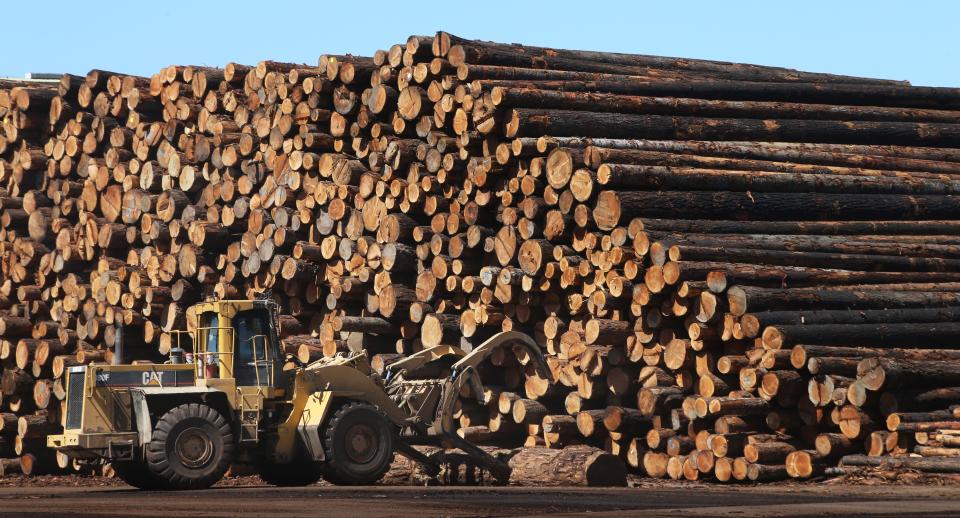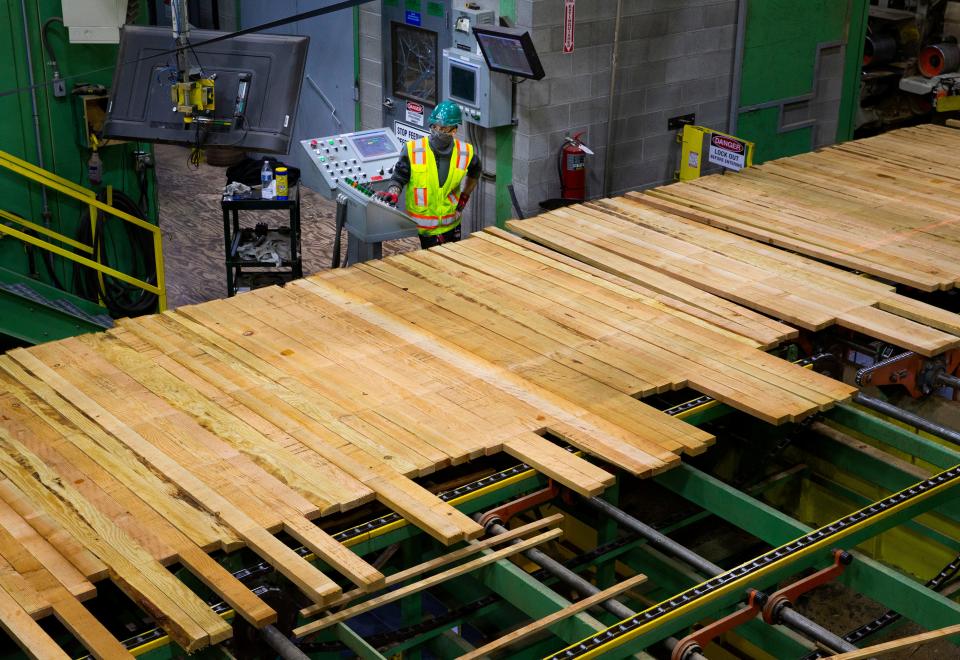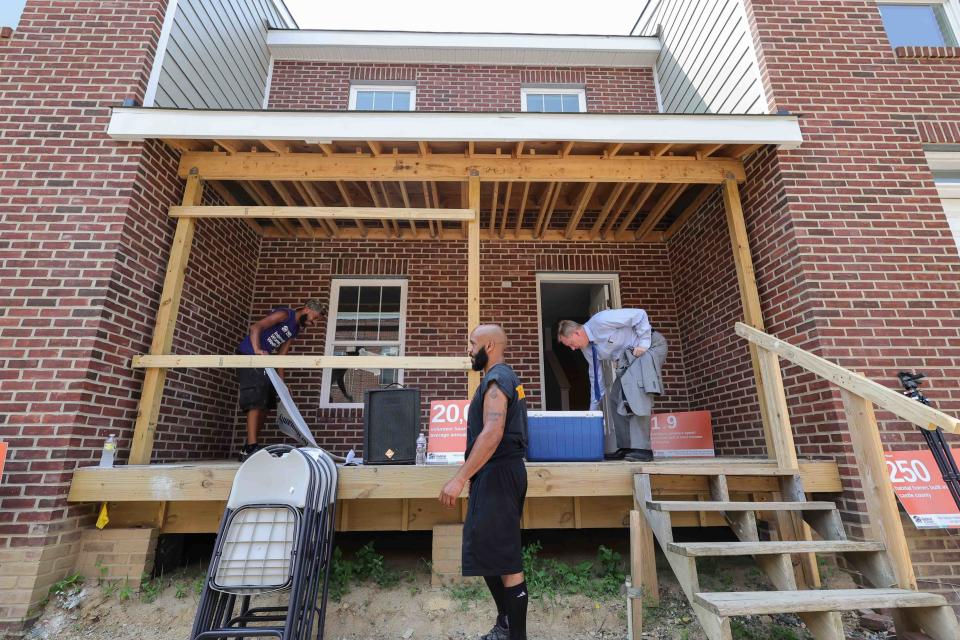Lumber prices are falling in Oregon and across the U.S. Could the housing market follow?
Lumber prices and supply have taken investors, contractors and consumers for a ride since 2020.
Erratic inventory and construction labor shortages combined with a Canadian lumber tariff have spiked lumber prices as the nation's appetite for new housing remains high. The effects of inflation and other construction material price fluctuations have, for home builders and buyers, tacked on additional costs in an already unwelcoming market.
"Lumber and everything related to the materials and supplies needed to build homes and office buildings is high. Everything across the board has gone up," said Home Builders Association of Lane County Executive Vice President Pete Barrell. "It means higher prices for the finished product, whoever the consumer is. Lumber is one big piece of that, but it's just one piece. Imagine the appliances and all the other materials: asphalt, concrete, roofing, all of that."
Related:As rebuilding begins in Oregon fire zones, price of lumber reaches new highs
Lumber is crucial as 9 out of 10 new single-family homes built in the U.S. are wood-framed, said the National Association of Home Builders (NAHB), a Washington, D.C.-based trade group.
Experts also wonder if there will be enough lumber supply to meet demand — and whether can Americans afford it.
"We can expect first-generation homebuyers who don't have the equity built from another home, and renters, particularly in dense markets (to be) priced out," NAHB Chief Economist Robert Dietz said. "Where do those people go?"

Is there a shortage of lumber?
Yes, there's a lumber shortage in the U.S, which relies heavily on Canadian imports, Dietz said.
As COVID wreaked havoc globally, sawmills slowed down, anticipating low demand. But housing needs increased during the pandemic, and those mills "did not ramp up production accordingly," the NAHB said.
Stinson Dean, CEO of Deacon Lumber in Kansas City, Mo., said the United States doesn’t have enough lumber to build the 2 million homes he estimates the nation needs.
Moody's Analytics projects the U.S. shortfall is around 1.5 million homes, fueling a spike in home sales and rental prices.
Buying a home?: How the 2022 housing market could be shifting in your favor
Lumber for a typical single-family home now ranges between $30,000 to $40,000 and about $10,000 per apartment unit, Dietz said.
Barrell said some Lane County homebuilders are facing other challenges than just the price of lumber. He said some contractors are seeing delays on items such as garage doors and appliances, slowing the availability of new homes.
"It can take a while to get the materials needed to finish a project," he said. "I've definitely heard of project delays."
Why are lumber prices so high?
Contributing factors include "high demand in the housing market, bottlenecks in the supply chain, and labor shortages," said Jonathan Paine, longtime president and CEO of the National Lumber & Building Material Dealers Association, a Washington, D.C.-based lobbyist group.
Additionally, the Biden administration last year doubled the tariffs on Canadian lumber imports from 9% to 17.9%, Dietz said. A reduction to 11.64% could come in August.
Oregonians looking for lumber aren't likely to find discounts just because the products come from their backyards, according to Oregon State University professor of applied economics Jeff Reimer. Oregon-made lumber is sent to customers around the country and beyond, and that demand keeps local prices fairly consistent with other places.
"Our lumber is not cheaper here than it would be in Kansas or something. The price of lumber is the same everywhere and the fact that we live near the forests doesn't mean a thing to us," Reimer said.

Are lumber prices coming down?
Yes. Lumber prices fell as low as $780 per thousand board feet in May and currently are trading below the $650 per thousand board feet, according to Chicago Mercantile Exchange. That's the lowest point for lumber this year – but still higher than the 2020 high of $400 per board foot.
It was just three months ago that lumber was trading for as much as $1,357 per thousandboard feet,not far from its peak price of $1,733 about this time a year ago, according to business data website Statista.
Paine expects lumber's price volatility to continue.
Reimer said it's possible rising mortgage rates could put downward pressure on the home construction industry as fewer people are able to afford homes, potentially shrinking lumber prices. But demand for homes nationwide is currently so high he said it seems unlikely there will be a significant decrease in the demand for lumber.

Could lower lumber prices help housing market prices?
Possibly. Nine out of 10 new single-family homes built in the U.S. are wood-framed, the NAHB estimates, so savings from lower lumber prices could reach consumers.
But some experts believe that President Biden will have to take action to improve the country's housing supply and lower prices on homes and materials, including lumber.
Last month, the president announced an action plan to spur the supply of affordable housing amid a 40-year-high inflation rate. He hopes to close the "housing supply gap" within five years.
In many Oregon cities, including Eugene-Springfield, homebuilding is limited by the availability of empty lots, Barrell said. The available lots are expensive, he said, and many present costly building challenges, such as steep elevations.
Though recent changes in building policy and practices are encouraging denser construction in already-developed areas, Barrell said it could be years before that truly affects home prices. For the near future, he expects little change.
"Short term, I don't see any big, magic cure," he said. "There aren't suddenly going to be a bunch of lots available."
Register-Guard reporter Adam Duvernay contributed to this article.
Follow Terry Collins on Twitter: @terryscollins
This article originally appeared on USA TODAY: Will Oregon housing market prices fall with cost of lumber?

